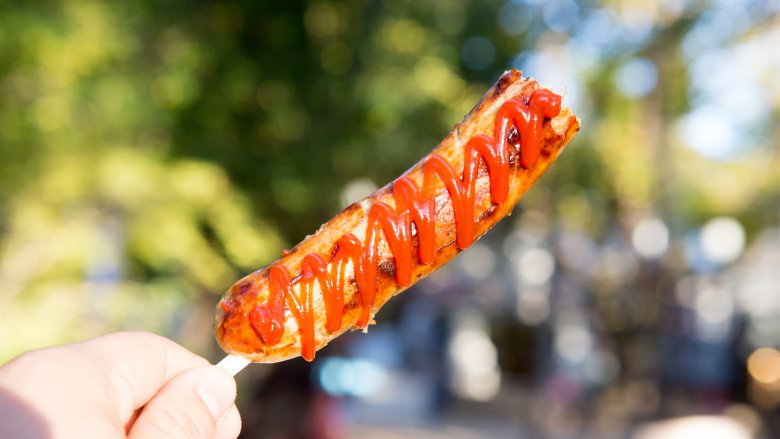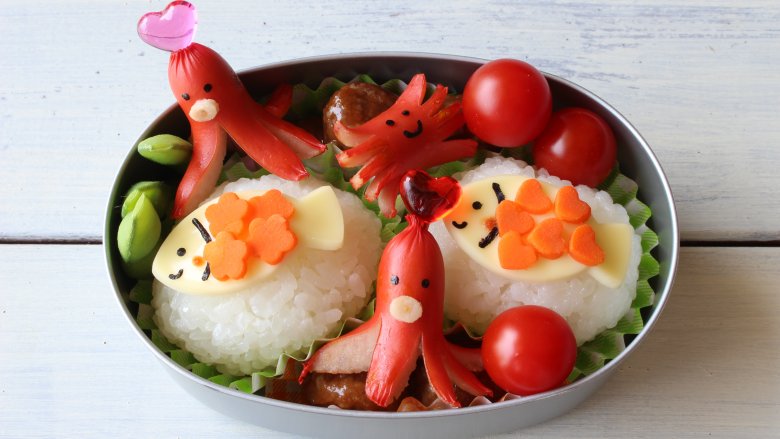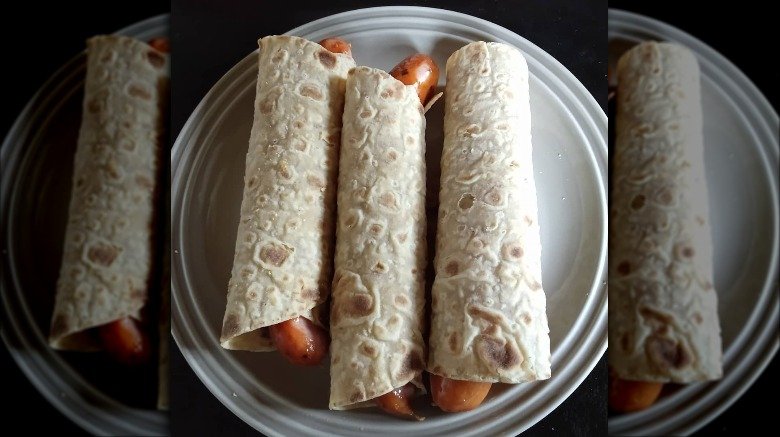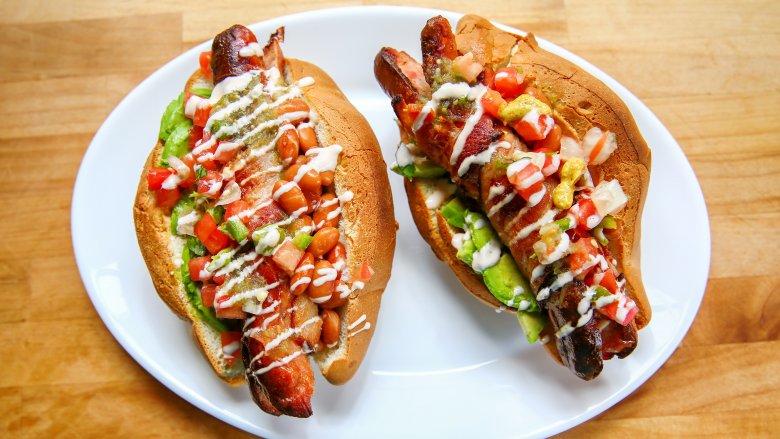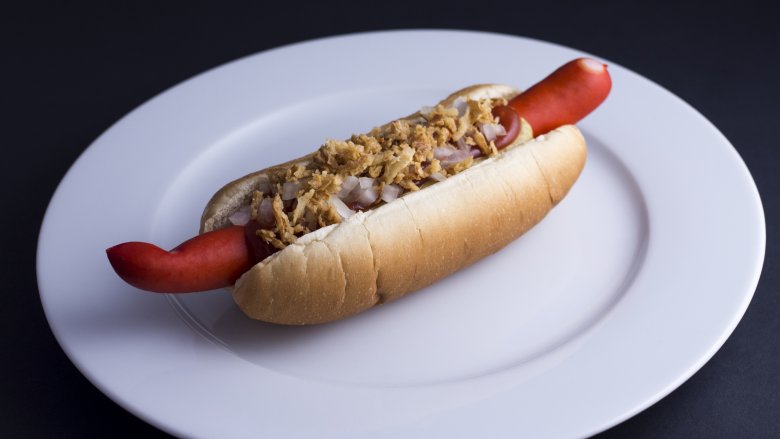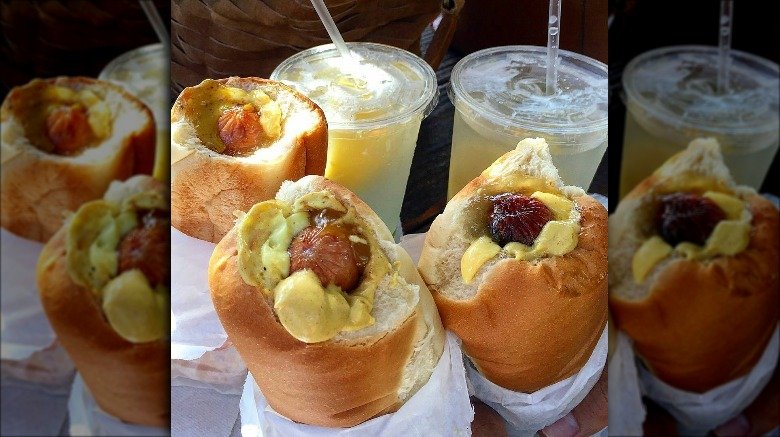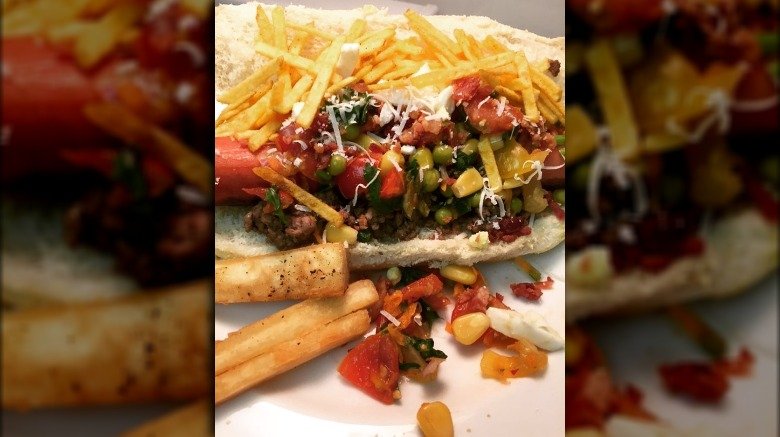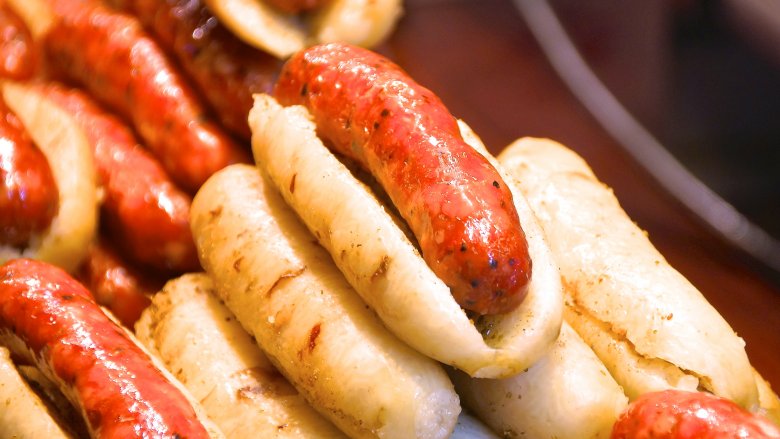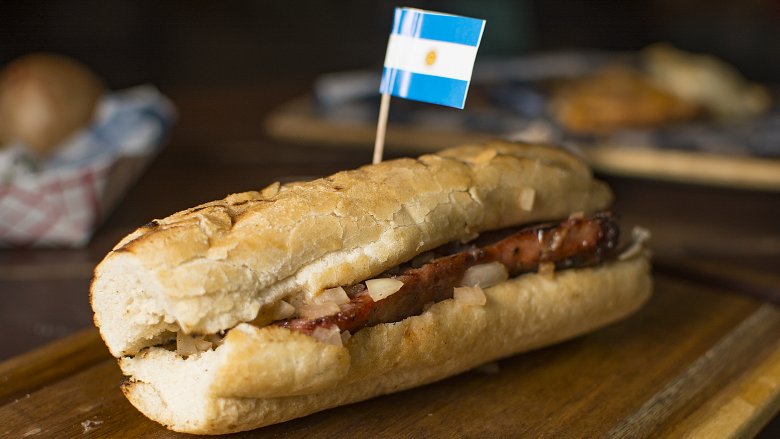The Weirdest Types Of Hot Dog From Around The World
The hot dog has got to be one of America's finest food traditions. In its most basic form — one dog in a bun with ketchup and mustard — it's recognized and loved up and down the country. But America is home to countless different variations of hot dog, too. From Atlanta's slaw to Chicago's pickle and relish to Detroit's beef chili, every corner of the United States has its own array of unique toppings that really make their hot dogs their own.
Go beyond America's borders, however, and you'll find all kinds of recipes and concoctions that are far stranger than anything you've ever seen before. Almost every country on Earth has incorporated the hot dog into their culinary tradition in some form or another, and the vast majority of them are inspired by the quirks and characteristics of the places in which they're eaten. Some of these hot dogs have utterly bizarre (to us) toppings; others eschew the bun for more local breads and pastries — but all of them are weird, and all of them are wonderful in their own way. These are the strangest types of hot dog from around the world.
South Korea's tokkebi is a deep-fried hot dog delight
Hop over to the other side of the Pacific and you'll find some pretty crazy stuff going on with hot dogs. South Korea, for example, is the home of tokkebi. Tokkebi is a kind of mad combination of lots of different kinds of street foods — put short, it's a hot dog deep fried in batter and crusted with french fries, slathered in sauce and served on a stick. It's almost entirely found at street food vendors around the country, and occasionally comes crusted with ramen instead of french fries, or some kind of combination of the two.
So don't expect to find gourmet tokkebi popping up at some fancy restaurant anytime soon; this is an on-the-go snack served throughout the day (and often into the night) at busy stalls in city markets, usually for only a few thousand won — a couple of dollars, basically. It's cheap, convenient and delicious, in a guilty kind of way, just like all good hot dogs are. Even if it's pushing the definition of "hot dog" a little.
Sweden's tunnbrödsrulle hot dog calls a lot into question
Over the last few years, a disproportionate amount of effort has been put into the debate over whether a hot dog is counted as a sandwich. Among the many, many arguments made on either side of this debate is the contention that sandwich bread must be open on all sides, whereas, because hot dog buns are partially enclosed, they are counted as something different entirely. Simple, right? Well, God knows what they'd make of the tunnbrödsrulle.
It's definitely not a sandwich, that's for sure. But it barely looks like a hot dog, either. Tunnbrödsrulle, a Swedish street food recipe, is made up of hot dog, mashed potato, lettuce, shrimp salad, mayonnaise dressing, onions, and ketchup and mustard, served in a tortilla or flatbread wrap. Nothing about that exactly screams "hot dog," but it's sure as hell not a sandwich, either. You could probably just call it a wrap, but... it does have a hot dog inside it. And that's what makes a hot dog a hot dog, right? So it is technically a hot dog, even if it isn't... isn't it? The whole thing inspires an existential crisis at the very first glance, and that's before you even get to the mashed potato. What is this?
China loves its hot dog pastries
If you weren't already flailing around in a universe of anxiety based on the whole bread/bun/tortilla nightmare, just wait until pastries get thrown into the mix. This new level of stress comes courtesy of the Chinese, who have combined the classic dog with a number of pastries of all shapes and sizes. They're pretty popular in China, being sold in bakeries across the country, and some places have entire sections dedicated to them.
According to travel blog Vagabond Journey, China is home to an endless range of different kinds of hot dog pastry. They're made with muffins, danishes, sliced bread, and more; and topped with everything from mayonnaise, to cheese, to frosting, to egg dough. That same travel blog also describes them as "old, stale and, often, [served] at room temperature." In a way, you've got to give credit to these Chinese bakeries for having the gall to quite literally throw together a load of completely incompatible western foods in an attempt to make them stick. Stale hot dog in a danish with cheese on top. Why not?
Japan is home to the octopus hot dog
Move over to Japan and things — rather predictably — become peak weird. Feast your eyes on the octopus hot dog, one of the country's most popular inclusions in the traditional bento box. In case you're unaware, a bento box is kind of like a little meal for one contained within a box and usually made up of any combination of rice, noodles, fish, meat, and vegetables. Nowadays, presentation is a huge part of the bento box experience, and the Japanese have become highly skilled at making them look funky.
It's inside your bento box that you're going to find the octopus hot dog. They're very easy to make: all you do is slice up a hot dog to look like an octopus, before microwaving it to make the tentacles shrivel in the heat. Throw it in with some rice, some vegetables, and a little soy sauce and you've got the makings of a classic Japanese lunch-on-the-go.
The Czech Republic's párek v rohlíku is a hot dog that's not too crazy
The Czech variation on the hot dog is known as párek v rohlíku, which literally means "sausage in roll." The actual components aren't particularly out of the ordinary for a hot dog — it's made up of a classic wurst, a few condiments, and a crusty bread roll, none of which are particularly out of the ordinary for a European hot dog. Where the párek v rohlíku comes into its own, however, is in its shape.
Rather than slicing a bun in half and placing the sausage inside, the top of the rohlíku is sliced off, a hole is punched in the bread and the sausage is placed into it with the condiments. What results is the kind of thing you'd get if you crossed the ingredients of a hot dog with the structure of an ice cream cone. A little weird, sure — but let's be honest, it's no octopus.
Peru's salchipapas is basically a hot dog salad
Salchipapas is a Peruvian street food that seriously stretches the meaning of the term "hot dog." This hugely popular dish originated as a poor man's food but is now enjoyed all around the country and beyond, including in Colombia, Bolivia and Ecuador. Often found at street vendors, salchipapas ("salchi" meaning sausage and "papas" meaning potatoes) is essentially made of sliced fried sausage on a bed of fries, accompanied by ketchup, chili sauce, mustard and mayo. Variations on the recipe also throw in garnishes such as fried eggs, cheese, tomatoes, and lettuce.
So no, there's no bun. There's no bread of any kind, in fact — not even a pastry. With that in mind, you could certainly make a decent argument that this isn't a hot dog at all. But fries are close enough to bread, the sauces are classic hot dog staples, and the dish is centered around just the kind of sausage you would find in any other dog. It's a tough call, but we're going to allow it.
Norway's pølse hot dog is cheap and tasty street food
The pølse is a little bit like the tunnbrödsrulle, if the tunnbrödsrulle buckled up, got its act together and dropped all those silly fillings. According to Cheapskate's Guide to Oslo (and they'd know) the pølse is the "easiest and cheapest fast food you can find in Oslo."
It's about as simple as a hot dog can get. One dog, served in a tortilla-style potato wrap, topped with ketchup and mustard. In fact, it looks like the kind of thing you might concoct late at night, if you really wanted a hot dog — but didn't quite have the right ingredients in your cupboards. It's huge in Norway, though. They're a staple at kids' parties, make frequent appearances at dinner tables, are often enjoyed by commuters and travelers and show up in practically every convenience store in the country. There's even a National Pølse Day on May 17th.
Variations on the pølse do exist — for example, some are wrapped in bacon, while others are mixed with chili, cheese, or onion. And at prices ranging from 25 to 45 NOK (somewhere around $2 to $5), they really are a steal, too.
Sonoran hot dogs are so good, they've crossed borders
The Sonoran hot dog may have originated in the Mexican state after which it's named, but it has since spread beyond the country's borders. It's made by wrapping a frankfurter hot dog in bacon and grilling them until crispy. The dog is then placed inside a bolillo, which is a kind of bread roll with a split top. The whole thing is then topped with pinto beans, chopped tomatoes, onions, mayonnaise, mustard, and jalapeño salsa, with a chile pepper served on the side.
The prevalent theory suggests that Sonoran hot dogs were first sold, and became popular, at baseball games in Sonora during the 1940s. Almost half a century later, they found more popularity with the area's students, after which street vendors began selling them on campus. Nowadays, however, they're also found as far away as Arizona, in cities such as Phoenix and Tucson. According to Benjamin Galaz, an Arizonan restaurateur who began his career selling hot dogs from a cart, the Sonoran hot dog is a dog of two countries. "The Sonoran hot dog," he told NBC, "represents a fusion of flavors and cultures from the two countries, Mexico and the United States."
Denmark's pølser hot dog is for special occasions
Just like in Norway, the Danish hot dog is known as the pølse — but this version is very different to that found in Norway. Described by Itinari as "the soul of Danish culinary culture," the Danish hot dog is served on a number of different special occasions, such as during Easter and late night at weddings, and can be found at hot dog wagons around the country. The most popular variant on the country's hot dog is made up of a remarkably vibrant red grilled sausage that extends far beyond the edges of the hot dog's bun.
This red color is by far the strangest thing about the Danish pølse, and brings to mind other types of similarly-colored sausage such as the British saveloy. In fact, the red sausage in Denmark dates back to the 1920s, and was created by vendors looking to spruce up their bad produce by dipping them in red dye and selling them for cheap. On top of today's Danish dogs, you'll find onions, sliced pickles, mustard, ketchup and Danish remoulade. And hopefully no dye.
Hawaii's Puka Dog is a mish-mash of hot dog traditions
Hawaii's contribution to the hot dog menagerie comes in the form of the Puka Dog. Hawaii's choice position in the Pacific Ocean means its culinary traditions have been influenced by a bunch of different countries, including the U.S., China, Japan and Europe (in particular the Portuguese, many of whom emigrated to the islands in the 19th century). The Puka Dog is a mish-mash of decades of national food traditions. A Polish sausage is cooked on a grill and jammed into a special hollow loaf, kind of like the Czech hot dog, only softer and with the sausage poking out of both ends. These dogs are then dressed with tropical mustards, fruit relishes, lemon garlic sauce and whatever secret sauces the vendor might have created themselves.
Look elsewhere in Hawaii and you'll also find hot dogs made with Portuguese sausage served over rice or in sweet buns, bright red Hawaiian Winners, Japanese-style Arabiki, waffle dogs, hot dogs dipped in donut batter, hot dogs wrapped in seaweed and sticky rice, and even Spam dogs. It's like the United Nations of hot dogs.
Brazil's completo hot dog is a massive feast
The remarkable thing about Brazilian hot dogs isn't their shape, or what their buns are made of, or even really their ingredients. They're not made of tortilla, they aren't bright pink, and they're definitely not shaped like octopuses. No, the thing about Brazil's hot dogs is just how crazy big they are. These hot dogs are often sold from street carts after dark, and can usually be purchased for about the equivalent of $1. So what do you get for that? Well, the hot dog known as the completo usually includes a standard hot dog, ground beef, bell peppers, tomatoes, onions, canned corn, peas, Parmesan cheese, shredded carrots, diced ham or bacon, cilantro, potato sticks, and a hard boiled quail egg on top. Sometimes, the bun is also laid on a bed of mashed potatoes. Basically, they're massive.
Sadly, the (admittedly fair) lifting of laws that once restricted food vendors to selling hot dogs means other street foods are now flooding into Brazilian cities, and completo hot dogs are becoming less popular. Still, if you can find one, it's definitely worth a go — no other hot dog in the world provides such a feast.
Thailand's Khanom Tokyo hot dog is more like breakfast
Thailand's variation on the hot dog constitutes an unwelcome return to the whole conundrum of what a hot dog becomes when you place it in a different kind of receptacle. Known as Khanom Tokyo, this dish — which is made from pancake dough cooked in a flat pan — often actually contains sweets and other savory fillings such as quail eggs or cream, and is regularly served as a dessert. The dish in general originates in the 1960s, where they were first served at a Japanese department store that had opened up a location in Thailand. Sometimes, however, street food vendors in Thailand will place hot dog sausages inside them, essentially creating a kind of spin-off of the more recognizable hot dogs you'll find elsewhere.
What you've got here, really, is a hot dog pancake. From the looks of it, some vendors can be pretty gung-ho with the fillings they include beyond the simple sausage, while others go completely plain. Either way, they appear to be a hugely popular street food in Thailand — probably worth at least a look-in, even if they are a little odd.
Taiwan's Da Chang Bao Xiao Chang is the strangest hot dog of all
Taiwan's version of the hot dog is something utterly unique. Da Chang Bao Xiao Chang, which literally means "big sausage wrap small sausage," is a street food commonly found in Taiwan's night markets. At first glance, it actually looks a lot like a normal hot dog. But while the main sausage is indeed made of meat, the "bun" is actually another "sausage" made of sticky rice. The whole thing is topped with lettuce, salted vegetables and garlic, as well as a range of customizable flavors and sauces including black pepper and wasabi.
They're generally quite small, too, but that's probably to be expected when you're trying to hold up a sausage and all those toppings with rice. All in all, top marks to Taiwan for creating a hot dog that looks like a hot dog and probably smells like a hot dog, but which many people would still probably argue isn't a hot dog at all.
Argentina's Choripán is a hot dog is so much better than what we're used to
Choripán, Argentina's own hot dogs, hold all the characteristics of your classic hot dog set-up, in the sense that it features a sausage contained within bread. No rice-based trickery, no bizarre buns, no toppings overload. Sausage in a bun. Simple, right?
Well, yes. But where choripán distinguishes itself from its many other cousins is in the ingredients themselves. Most notably, the sausage is made of chorizo (hence the name), which is a high-quality and frankly superior type of meat than your usual mystery meat. The chorizo is seared to make it far crispier than other hot dogs, while the bun is also toasted for an extra crunch. Toppings usually include chimichurri sauce or tomato salsa.
These hot dogs are hugely popular dishes found at both sporting events and on the street. More than that, however, they're also proof enough that it's entirely possible to surpass the plain and ordinary hot dog — without losing any of the qualities that makes them so good in the first place.
